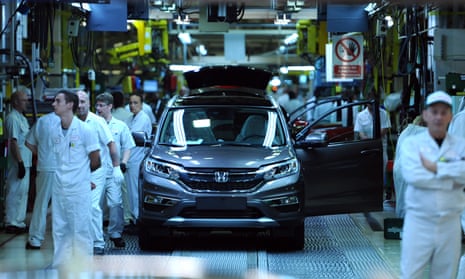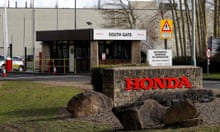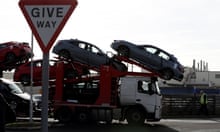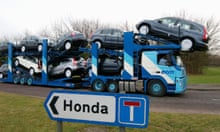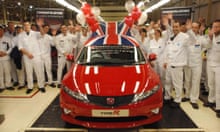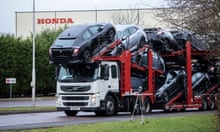A senior figure at Honda listed a catalogue of risks posed by Brexit at a briefing near its Swindon plant last year, fuelling doubts about the carmaker’s insistence that Britain’s withdrawal from the EU had nothing to do with the factory’s closure.
The Japanese carmaker, which said earlier this week that the closure was “not a Brexit-related issue”, appeared to dilute its rhetoric after the Guardian presented it with details of what Swindon residents were told last year.
During a meeting on 14 September – five months before the firm said the plant would close from 2021 threatening 7,000 jobs, including 3,500 directly employed at the plant – Honda Motor Europe’s government affairs manager, Patrick Keating, told locals the company was committed to the site.
But, according to notes taken by local Labour councillor Jane Milner-Barry, he also flagged up a litany of reasons why Brexit, in particular the prospect of a no-deal scenario, posed a threat to the factory.
Keating predicted that Brexit could interrupt crucial “just in time” delivery of 2m parts a day, 20% of which come from Europe and which allow smooth operation of the company’s supply chain.
Brexit also raised the prospect of increased customs controls and paperwork, he said, warning that suppliers might have to fill out 60,000 customs declaration forms a year. He also pointed out that 20% of staff at Swindon were EU nationals and expressed concern about regulatory divergence that could force the company to carry out two differing sets of tests on vehicles.
Keating said Honda’s requirements included tariff-free barriers, access to the EU’s free-trade agreements with other countries, access to talent and the ability to move staff from one country to another, a clear plan on regulations and a predictable Brexit process with a meaningful transition period.
Honda repeatedly dismissed Brexit as a factor this week, saying its decision was “not influenced by Britain’s plans to leave the EU”, a claim cited by the prime minister on Wednesday.
But in a fresh statement it softened its tone, saying that “no one single event” was to blame. “Honda is on record as stating that its preferred scenario following Brexit is one that delivers frictionless trade, access to talent and regulatory alignment,” the company said.
“It is true that a ‘no-deal’ scenario would cause a number of challenges for our operations. However, no one single event has led to the proposal to cease production at Swindon. The decision is in response to unprecedented change in the global automotive industry and the need to deploy electrification technologies across our business.”
Multiple factors are understood to be behind the closure, including global market conditions, the shift to electric vehicles and a free-trade agreement with the EU that will allow Japanese carmakers to export cars tariff-free from 2027.
